Psychiatric Health and Nursing: Understanding Depression and Antidepressant Medications
VerifiedAdded on 2023/06/12
|12
|3453
|318
AI Summary
This essay discusses the psychopathology of depression, impact on individual and family, antidepressant medication categories, examples, and side effects. The role of nurses in supporting patients with depression is also presented.
Contribute Materials
Your contribution can guide someone’s learning journey. Share your
documents today.
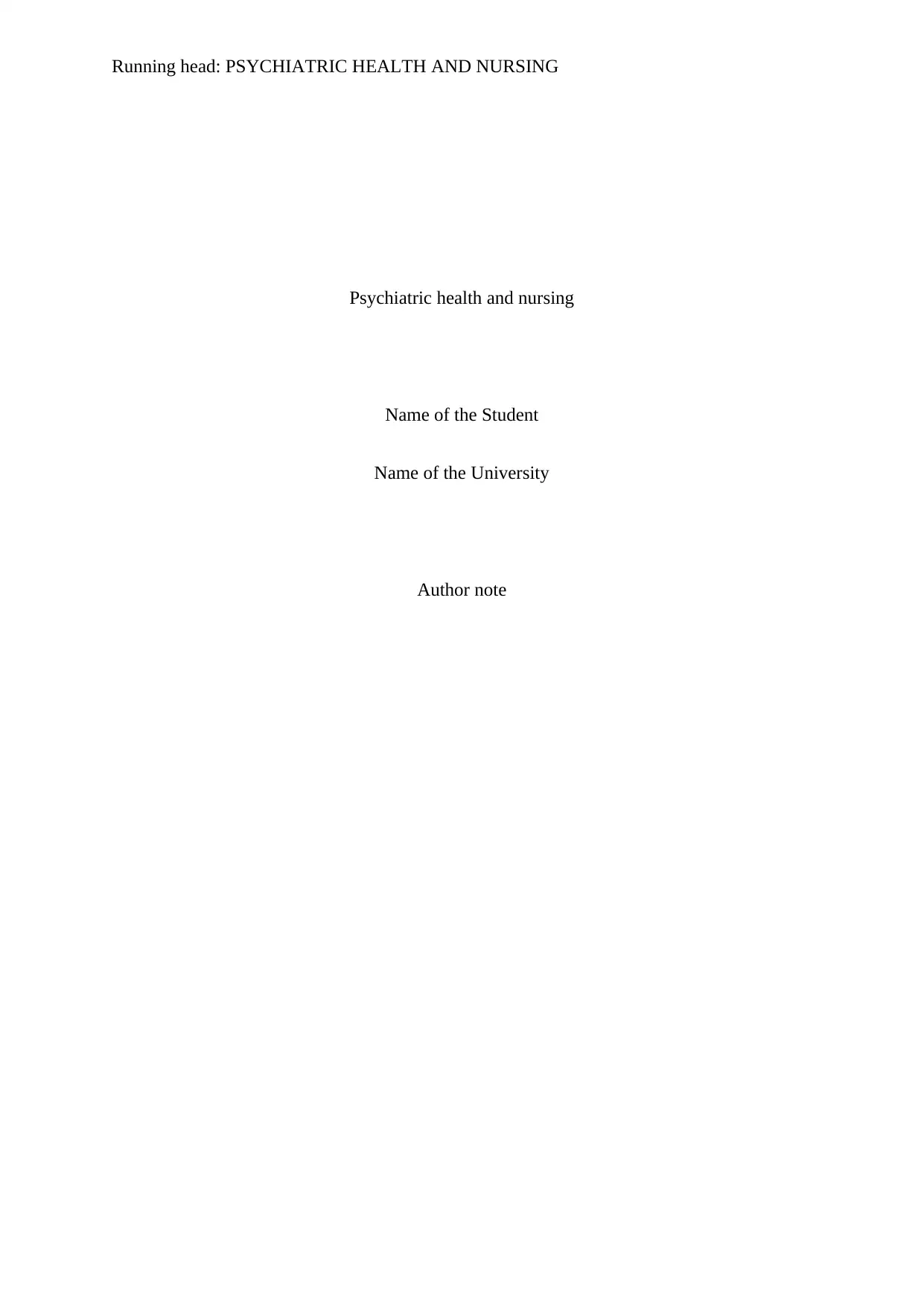
Running head: PSYCHIATRIC HEALTH AND NURSING
Psychiatric health and nursing
Name of the Student
Name of the University
Author note
Psychiatric health and nursing
Name of the Student
Name of the University
Author note
Secure Best Marks with AI Grader
Need help grading? Try our AI Grader for instant feedback on your assignments.
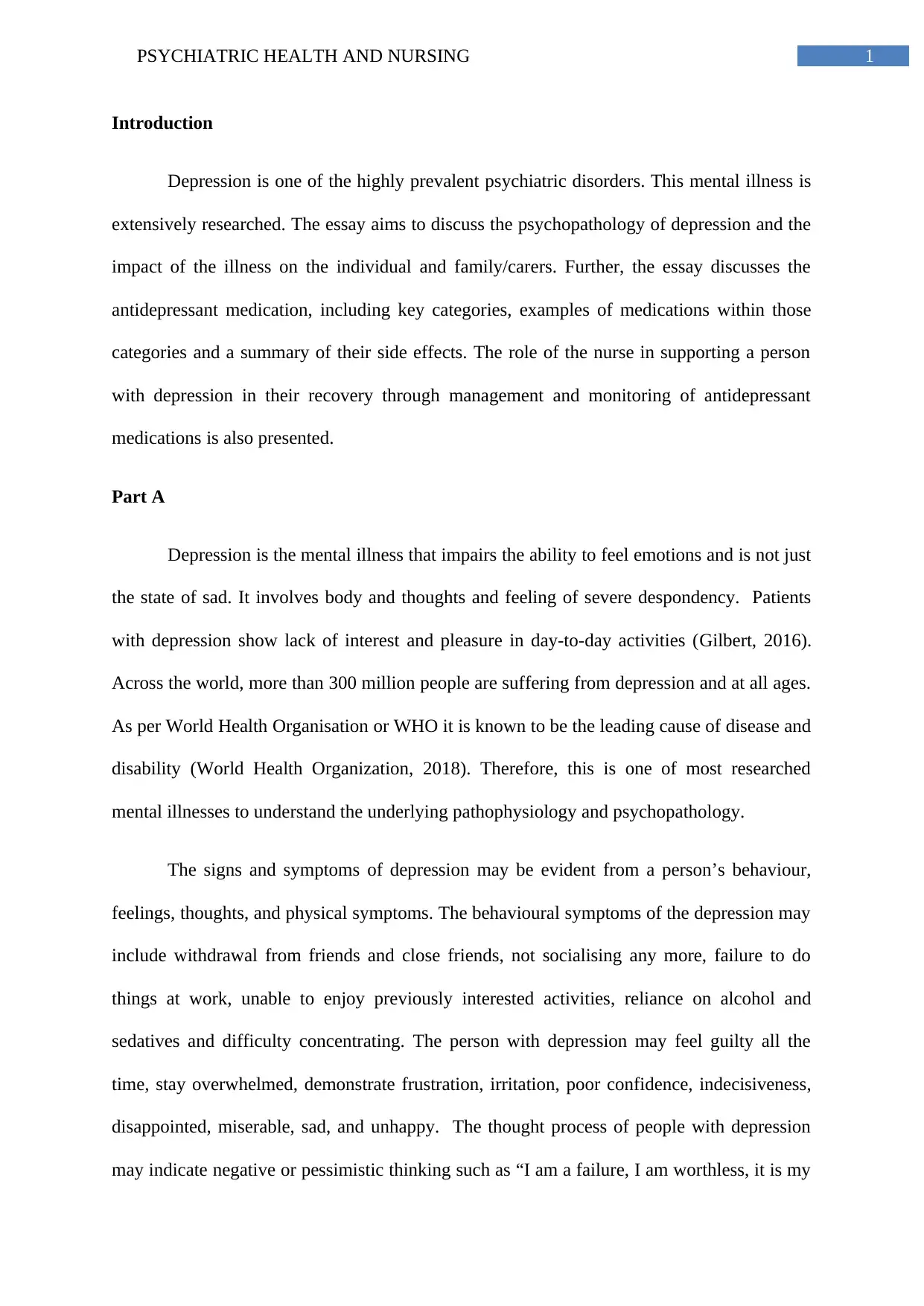
1PSYCHIATRIC HEALTH AND NURSING
Introduction
Depression is one of the highly prevalent psychiatric disorders. This mental illness is
extensively researched. The essay aims to discuss the psychopathology of depression and the
impact of the illness on the individual and family/carers. Further, the essay discusses the
antidepressant medication, including key categories, examples of medications within those
categories and a summary of their side effects. The role of the nurse in supporting a person
with depression in their recovery through management and monitoring of antidepressant
medications is also presented.
Part A
Depression is the mental illness that impairs the ability to feel emotions and is not just
the state of sad. It involves body and thoughts and feeling of severe despondency. Patients
with depression show lack of interest and pleasure in day-to-day activities (Gilbert, 2016).
Across the world, more than 300 million people are suffering from depression and at all ages.
As per World Health Organisation or WHO it is known to be the leading cause of disease and
disability (World Health Organization, 2018). Therefore, this is one of most researched
mental illnesses to understand the underlying pathophysiology and psychopathology.
The signs and symptoms of depression may be evident from a person’s behaviour,
feelings, thoughts, and physical symptoms. The behavioural symptoms of the depression may
include withdrawal from friends and close friends, not socialising any more, failure to do
things at work, unable to enjoy previously interested activities, reliance on alcohol and
sedatives and difficulty concentrating. The person with depression may feel guilty all the
time, stay overwhelmed, demonstrate frustration, irritation, poor confidence, indecisiveness,
disappointed, miserable, sad, and unhappy. The thought process of people with depression
may indicate negative or pessimistic thinking such as “I am a failure, I am worthless, it is my
Introduction
Depression is one of the highly prevalent psychiatric disorders. This mental illness is
extensively researched. The essay aims to discuss the psychopathology of depression and the
impact of the illness on the individual and family/carers. Further, the essay discusses the
antidepressant medication, including key categories, examples of medications within those
categories and a summary of their side effects. The role of the nurse in supporting a person
with depression in their recovery through management and monitoring of antidepressant
medications is also presented.
Part A
Depression is the mental illness that impairs the ability to feel emotions and is not just
the state of sad. It involves body and thoughts and feeling of severe despondency. Patients
with depression show lack of interest and pleasure in day-to-day activities (Gilbert, 2016).
Across the world, more than 300 million people are suffering from depression and at all ages.
As per World Health Organisation or WHO it is known to be the leading cause of disease and
disability (World Health Organization, 2018). Therefore, this is one of most researched
mental illnesses to understand the underlying pathophysiology and psychopathology.
The signs and symptoms of depression may be evident from a person’s behaviour,
feelings, thoughts, and physical symptoms. The behavioural symptoms of the depression may
include withdrawal from friends and close friends, not socialising any more, failure to do
things at work, unable to enjoy previously interested activities, reliance on alcohol and
sedatives and difficulty concentrating. The person with depression may feel guilty all the
time, stay overwhelmed, demonstrate frustration, irritation, poor confidence, indecisiveness,
disappointed, miserable, sad, and unhappy. The thought process of people with depression
may indicate negative or pessimistic thinking such as “I am a failure, I am worthless, it is my
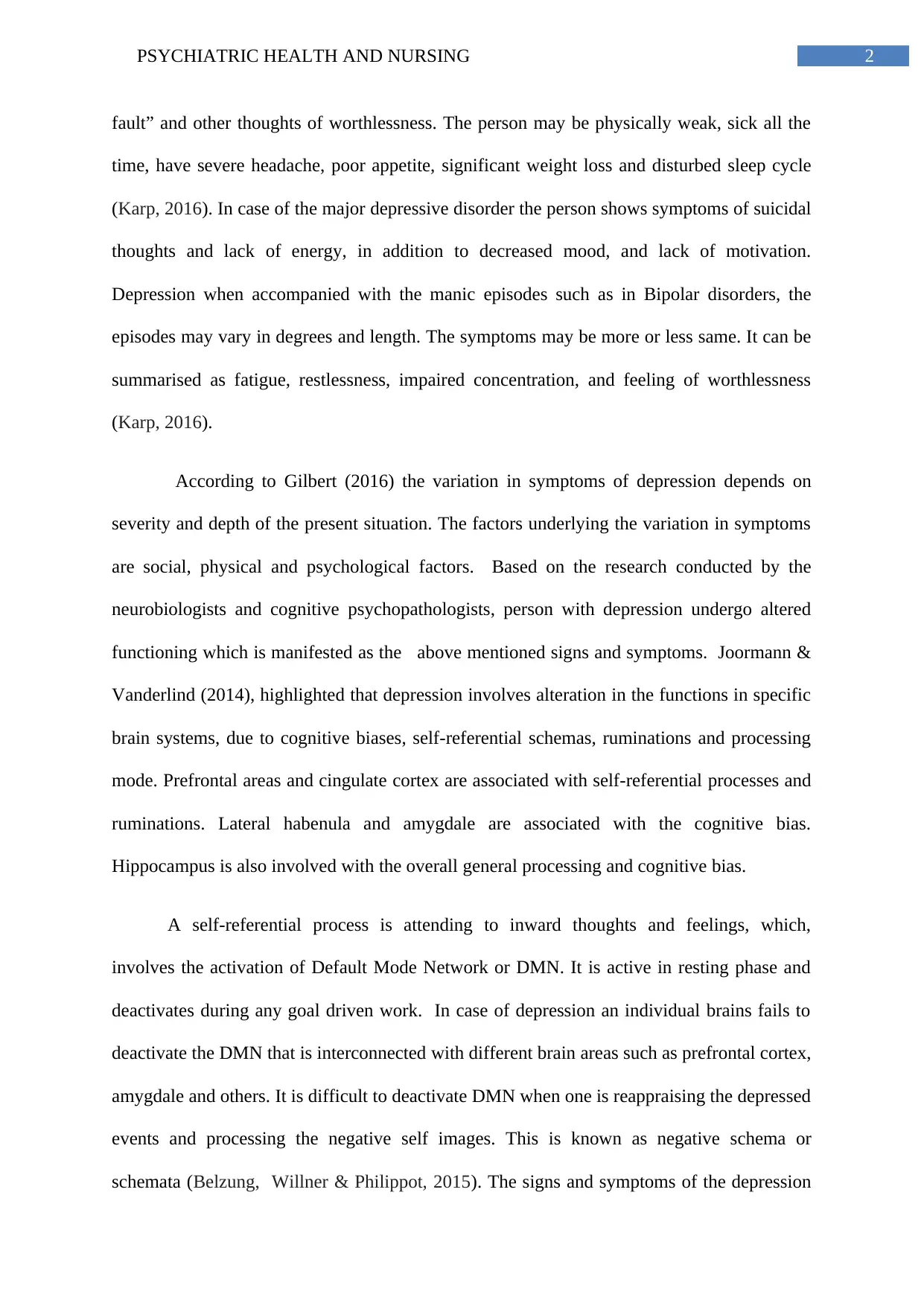
2PSYCHIATRIC HEALTH AND NURSING
fault” and other thoughts of worthlessness. The person may be physically weak, sick all the
time, have severe headache, poor appetite, significant weight loss and disturbed sleep cycle
(Karp, 2016). In case of the major depressive disorder the person shows symptoms of suicidal
thoughts and lack of energy, in addition to decreased mood, and lack of motivation.
Depression when accompanied with the manic episodes such as in Bipolar disorders, the
episodes may vary in degrees and length. The symptoms may be more or less same. It can be
summarised as fatigue, restlessness, impaired concentration, and feeling of worthlessness
(Karp, 2016).
According to Gilbert (2016) the variation in symptoms of depression depends on
severity and depth of the present situation. The factors underlying the variation in symptoms
are social, physical and psychological factors. Based on the research conducted by the
neurobiologists and cognitive psychopathologists, person with depression undergo altered
functioning which is manifested as the above mentioned signs and symptoms. Joormann &
Vanderlind (2014), highlighted that depression involves alteration in the functions in specific
brain systems, due to cognitive biases, self-referential schemas, ruminations and processing
mode. Prefrontal areas and cingulate cortex are associated with self-referential processes and
ruminations. Lateral habenula and amygdale are associated with the cognitive bias.
Hippocampus is also involved with the overall general processing and cognitive bias.
A self-referential process is attending to inward thoughts and feelings, which,
involves the activation of Default Mode Network or DMN. It is active in resting phase and
deactivates during any goal driven work. In case of depression an individual brains fails to
deactivate the DMN that is interconnected with different brain areas such as prefrontal cortex,
amygdale and others. It is difficult to deactivate DMN when one is reappraising the depressed
events and processing the negative self images. This is known as negative schema or
schemata (Belzung, Willner & Philippot, 2015). The signs and symptoms of the depression
fault” and other thoughts of worthlessness. The person may be physically weak, sick all the
time, have severe headache, poor appetite, significant weight loss and disturbed sleep cycle
(Karp, 2016). In case of the major depressive disorder the person shows symptoms of suicidal
thoughts and lack of energy, in addition to decreased mood, and lack of motivation.
Depression when accompanied with the manic episodes such as in Bipolar disorders, the
episodes may vary in degrees and length. The symptoms may be more or less same. It can be
summarised as fatigue, restlessness, impaired concentration, and feeling of worthlessness
(Karp, 2016).
According to Gilbert (2016) the variation in symptoms of depression depends on
severity and depth of the present situation. The factors underlying the variation in symptoms
are social, physical and psychological factors. Based on the research conducted by the
neurobiologists and cognitive psychopathologists, person with depression undergo altered
functioning which is manifested as the above mentioned signs and symptoms. Joormann &
Vanderlind (2014), highlighted that depression involves alteration in the functions in specific
brain systems, due to cognitive biases, self-referential schemas, ruminations and processing
mode. Prefrontal areas and cingulate cortex are associated with self-referential processes and
ruminations. Lateral habenula and amygdale are associated with the cognitive bias.
Hippocampus is also involved with the overall general processing and cognitive bias.
A self-referential process is attending to inward thoughts and feelings, which,
involves the activation of Default Mode Network or DMN. It is active in resting phase and
deactivates during any goal driven work. In case of depression an individual brains fails to
deactivate the DMN that is interconnected with different brain areas such as prefrontal cortex,
amygdale and others. It is difficult to deactivate DMN when one is reappraising the depressed
events and processing the negative self images. This is known as negative schema or
schemata (Belzung, Willner & Philippot, 2015). The signs and symptoms of the depression
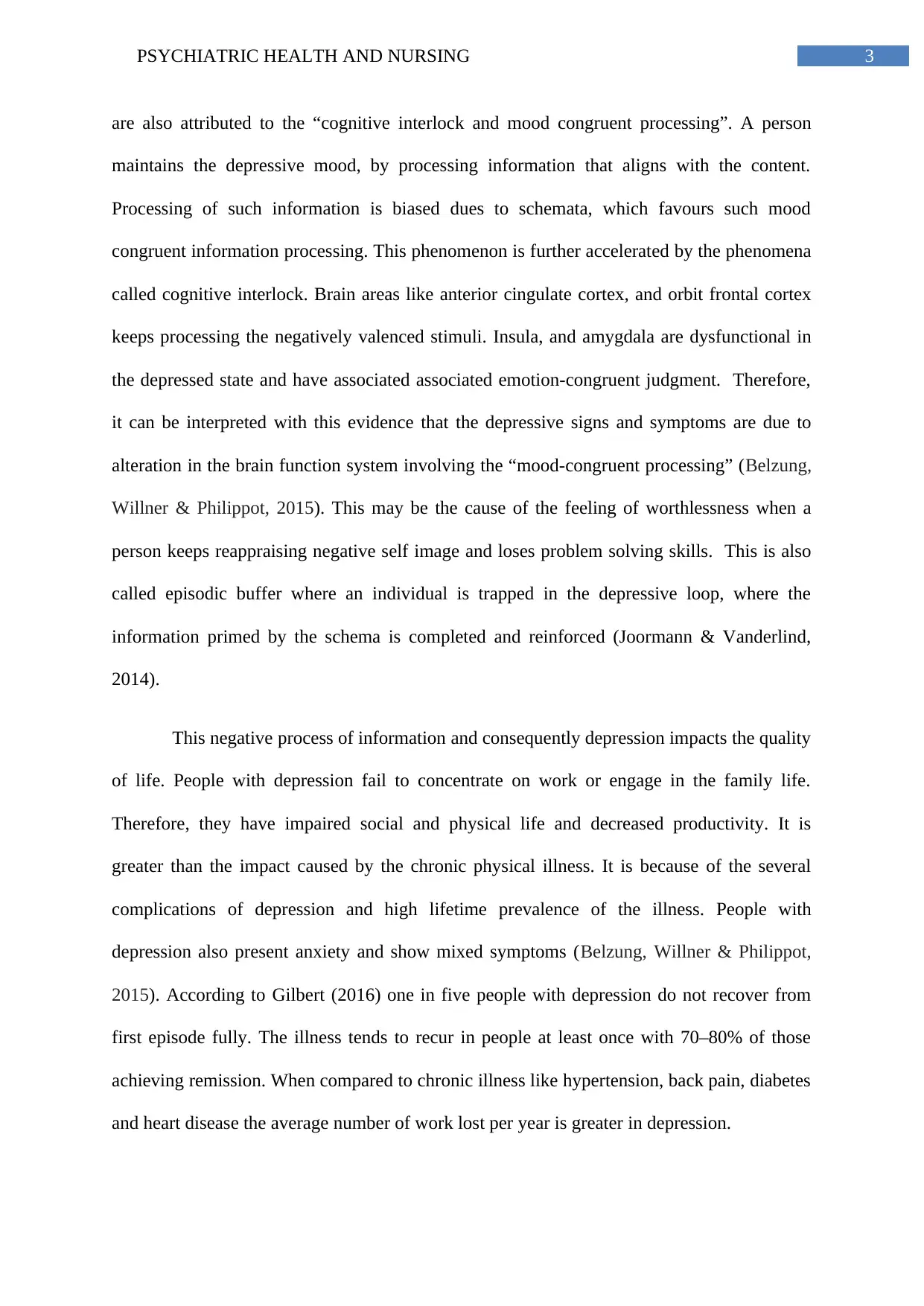
3PSYCHIATRIC HEALTH AND NURSING
are also attributed to the “cognitive interlock and mood congruent processing”. A person
maintains the depressive mood, by processing information that aligns with the content.
Processing of such information is biased dues to schemata, which favours such mood
congruent information processing. This phenomenon is further accelerated by the phenomena
called cognitive interlock. Brain areas like anterior cingulate cortex, and orbit frontal cortex
keeps processing the negatively valenced stimuli. Insula, and amygdala are dysfunctional in
the depressed state and have associated associated emotion-congruent judgment. Therefore,
it can be interpreted with this evidence that the depressive signs and symptoms are due to
alteration in the brain function system involving the “mood-congruent processing” (Belzung,
Willner & Philippot, 2015). This may be the cause of the feeling of worthlessness when a
person keeps reappraising negative self image and loses problem solving skills. This is also
called episodic buffer where an individual is trapped in the depressive loop, where the
information primed by the schema is completed and reinforced (Joormann & Vanderlind,
2014).
This negative process of information and consequently depression impacts the quality
of life. People with depression fail to concentrate on work or engage in the family life.
Therefore, they have impaired social and physical life and decreased productivity. It is
greater than the impact caused by the chronic physical illness. It is because of the several
complications of depression and high lifetime prevalence of the illness. People with
depression also present anxiety and show mixed symptoms (Belzung, Willner & Philippot,
2015). According to Gilbert (2016) one in five people with depression do not recover from
first episode fully. The illness tends to recur in people at least once with 70–80% of those
achieving remission. When compared to chronic illness like hypertension, back pain, diabetes
and heart disease the average number of work lost per year is greater in depression.
are also attributed to the “cognitive interlock and mood congruent processing”. A person
maintains the depressive mood, by processing information that aligns with the content.
Processing of such information is biased dues to schemata, which favours such mood
congruent information processing. This phenomenon is further accelerated by the phenomena
called cognitive interlock. Brain areas like anterior cingulate cortex, and orbit frontal cortex
keeps processing the negatively valenced stimuli. Insula, and amygdala are dysfunctional in
the depressed state and have associated associated emotion-congruent judgment. Therefore,
it can be interpreted with this evidence that the depressive signs and symptoms are due to
alteration in the brain function system involving the “mood-congruent processing” (Belzung,
Willner & Philippot, 2015). This may be the cause of the feeling of worthlessness when a
person keeps reappraising negative self image and loses problem solving skills. This is also
called episodic buffer where an individual is trapped in the depressive loop, where the
information primed by the schema is completed and reinforced (Joormann & Vanderlind,
2014).
This negative process of information and consequently depression impacts the quality
of life. People with depression fail to concentrate on work or engage in the family life.
Therefore, they have impaired social and physical life and decreased productivity. It is
greater than the impact caused by the chronic physical illness. It is because of the several
complications of depression and high lifetime prevalence of the illness. People with
depression also present anxiety and show mixed symptoms (Belzung, Willner & Philippot,
2015). According to Gilbert (2016) one in five people with depression do not recover from
first episode fully. The illness tends to recur in people at least once with 70–80% of those
achieving remission. When compared to chronic illness like hypertension, back pain, diabetes
and heart disease the average number of work lost per year is greater in depression.
Secure Best Marks with AI Grader
Need help grading? Try our AI Grader for instant feedback on your assignments.
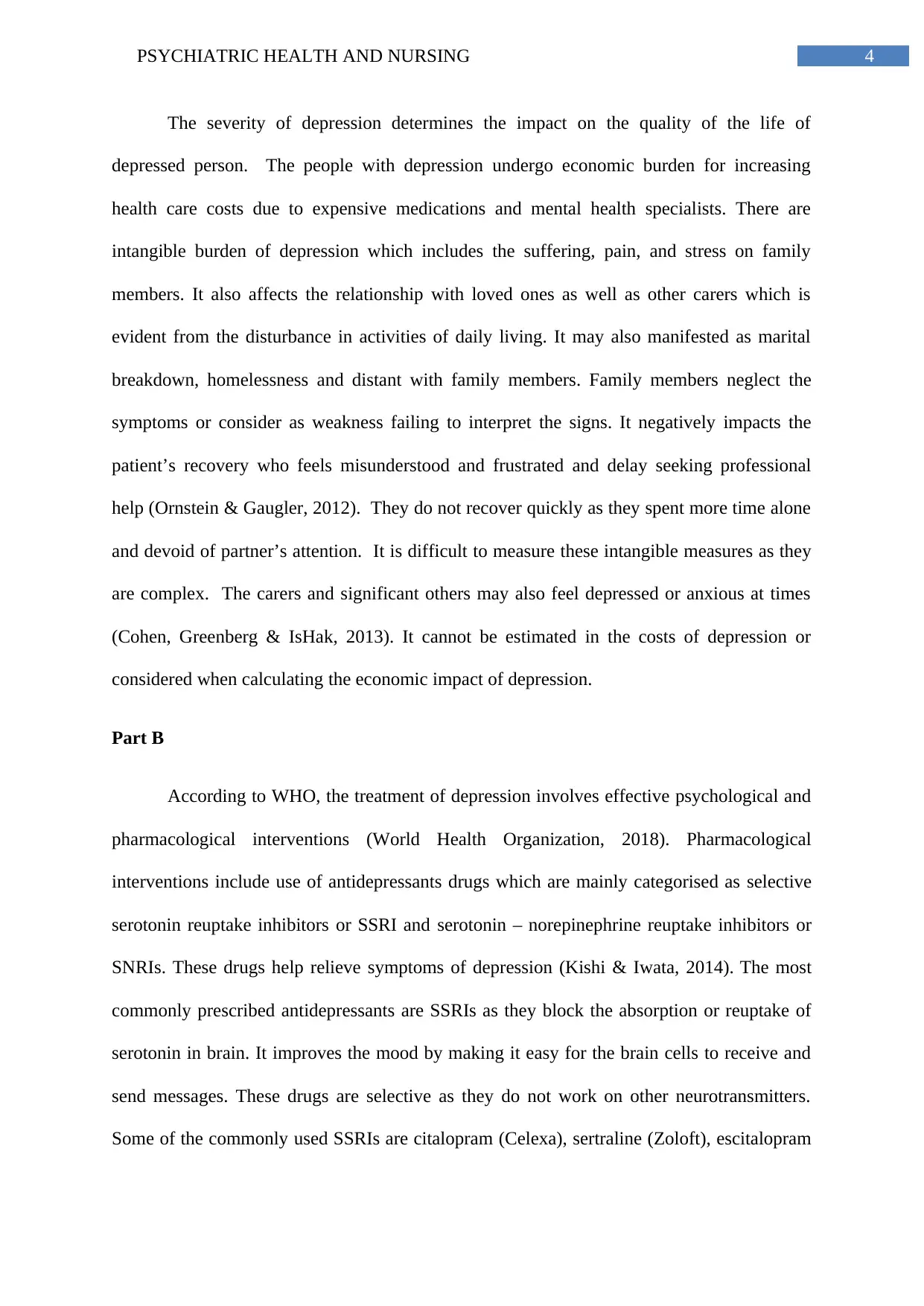
4PSYCHIATRIC HEALTH AND NURSING
The severity of depression determines the impact on the quality of the life of
depressed person. The people with depression undergo economic burden for increasing
health care costs due to expensive medications and mental health specialists. There are
intangible burden of depression which includes the suffering, pain, and stress on family
members. It also affects the relationship with loved ones as well as other carers which is
evident from the disturbance in activities of daily living. It may also manifested as marital
breakdown, homelessness and distant with family members. Family members neglect the
symptoms or consider as weakness failing to interpret the signs. It negatively impacts the
patient’s recovery who feels misunderstood and frustrated and delay seeking professional
help (Ornstein & Gaugler, 2012). They do not recover quickly as they spent more time alone
and devoid of partner’s attention. It is difficult to measure these intangible measures as they
are complex. The carers and significant others may also feel depressed or anxious at times
(Cohen, Greenberg & IsHak, 2013). It cannot be estimated in the costs of depression or
considered when calculating the economic impact of depression.
Part B
According to WHO, the treatment of depression involves effective psychological and
pharmacological interventions (World Health Organization, 2018). Pharmacological
interventions include use of antidepressants drugs which are mainly categorised as selective
serotonin reuptake inhibitors or SSRI and serotonin – norepinephrine reuptake inhibitors or
SNRIs. These drugs help relieve symptoms of depression (Kishi & Iwata, 2014). The most
commonly prescribed antidepressants are SSRIs as they block the absorption or reuptake of
serotonin in brain. It improves the mood by making it easy for the brain cells to receive and
send messages. These drugs are selective as they do not work on other neurotransmitters.
Some of the commonly used SSRIs are citalopram (Celexa), sertraline (Zoloft), escitalopram
The severity of depression determines the impact on the quality of the life of
depressed person. The people with depression undergo economic burden for increasing
health care costs due to expensive medications and mental health specialists. There are
intangible burden of depression which includes the suffering, pain, and stress on family
members. It also affects the relationship with loved ones as well as other carers which is
evident from the disturbance in activities of daily living. It may also manifested as marital
breakdown, homelessness and distant with family members. Family members neglect the
symptoms or consider as weakness failing to interpret the signs. It negatively impacts the
patient’s recovery who feels misunderstood and frustrated and delay seeking professional
help (Ornstein & Gaugler, 2012). They do not recover quickly as they spent more time alone
and devoid of partner’s attention. It is difficult to measure these intangible measures as they
are complex. The carers and significant others may also feel depressed or anxious at times
(Cohen, Greenberg & IsHak, 2013). It cannot be estimated in the costs of depression or
considered when calculating the economic impact of depression.
Part B
According to WHO, the treatment of depression involves effective psychological and
pharmacological interventions (World Health Organization, 2018). Pharmacological
interventions include use of antidepressants drugs which are mainly categorised as selective
serotonin reuptake inhibitors or SSRI and serotonin – norepinephrine reuptake inhibitors or
SNRIs. These drugs help relieve symptoms of depression (Kishi & Iwata, 2014). The most
commonly prescribed antidepressants are SSRIs as they block the absorption or reuptake of
serotonin in brain. It improves the mood by making it easy for the brain cells to receive and
send messages. These drugs are selective as they do not work on other neurotransmitters.
Some of the commonly used SSRIs are citalopram (Celexa), sertraline (Zoloft), escitalopram
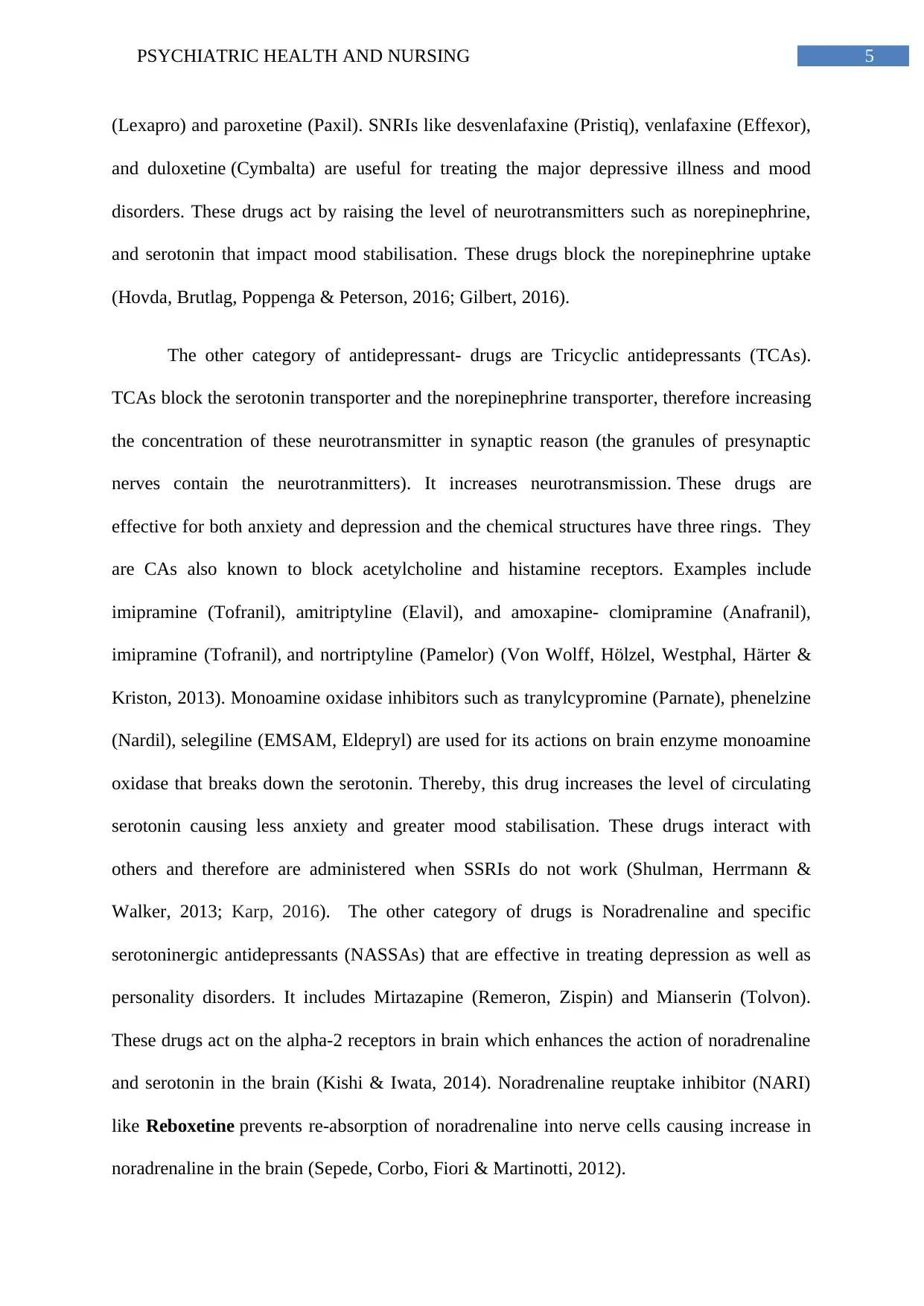
5PSYCHIATRIC HEALTH AND NURSING
(Lexapro) and paroxetine (Paxil). SNRIs like desvenlafaxine (Pristiq), venlafaxine (Effexor),
and duloxetine (Cymbalta) are useful for treating the major depressive illness and mood
disorders. These drugs act by raising the level of neurotransmitters such as norepinephrine,
and serotonin that impact mood stabilisation. These drugs block the norepinephrine uptake
(Hovda, Brutlag, Poppenga & Peterson, 2016; Gilbert, 2016).
The other category of antidepressant- drugs are Tricyclic antidepressants (TCAs).
TCAs block the serotonin transporter and the norepinephrine transporter, therefore increasing
the concentration of these neurotransmitter in synaptic reason (the granules of presynaptic
nerves contain the neurotranmitters). It increases neurotransmission. These drugs are
effective for both anxiety and depression and the chemical structures have three rings. They
are CAs also known to block acetylcholine and histamine receptors. Examples include
imipramine (Tofranil), amitriptyline (Elavil), and amoxapine- clomipramine (Anafranil),
imipramine (Tofranil), and nortriptyline (Pamelor) (Von Wolff, Hölzel, Westphal, Härter &
Kriston, 2013). Monoamine oxidase inhibitors such as tranylcypromine (Parnate), phenelzine
(Nardil), selegiline (EMSAM, Eldepryl) are used for its actions on brain enzyme monoamine
oxidase that breaks down the serotonin. Thereby, this drug increases the level of circulating
serotonin causing less anxiety and greater mood stabilisation. These drugs interact with
others and therefore are administered when SSRIs do not work (Shulman, Herrmann &
Walker, 2013; Karp, 2016). The other category of drugs is Noradrenaline and specific
serotoninergic antidepressants (NASSAs) that are effective in treating depression as well as
personality disorders. It includes Mirtazapine (Remeron, Zispin) and Mianserin (Tolvon).
These drugs act on the alpha-2 receptors in brain which enhances the action of noradrenaline
and serotonin in the brain (Kishi & Iwata, 2014). Noradrenaline reuptake inhibitor (NARI)
like Reboxetine prevents re-absorption of noradrenaline into nerve cells causing increase in
noradrenaline in the brain (Sepede, Corbo, Fiori & Martinotti, 2012).
(Lexapro) and paroxetine (Paxil). SNRIs like desvenlafaxine (Pristiq), venlafaxine (Effexor),
and duloxetine (Cymbalta) are useful for treating the major depressive illness and mood
disorders. These drugs act by raising the level of neurotransmitters such as norepinephrine,
and serotonin that impact mood stabilisation. These drugs block the norepinephrine uptake
(Hovda, Brutlag, Poppenga & Peterson, 2016; Gilbert, 2016).
The other category of antidepressant- drugs are Tricyclic antidepressants (TCAs).
TCAs block the serotonin transporter and the norepinephrine transporter, therefore increasing
the concentration of these neurotransmitter in synaptic reason (the granules of presynaptic
nerves contain the neurotranmitters). It increases neurotransmission. These drugs are
effective for both anxiety and depression and the chemical structures have three rings. They
are CAs also known to block acetylcholine and histamine receptors. Examples include
imipramine (Tofranil), amitriptyline (Elavil), and amoxapine- clomipramine (Anafranil),
imipramine (Tofranil), and nortriptyline (Pamelor) (Von Wolff, Hölzel, Westphal, Härter &
Kriston, 2013). Monoamine oxidase inhibitors such as tranylcypromine (Parnate), phenelzine
(Nardil), selegiline (EMSAM, Eldepryl) are used for its actions on brain enzyme monoamine
oxidase that breaks down the serotonin. Thereby, this drug increases the level of circulating
serotonin causing less anxiety and greater mood stabilisation. These drugs interact with
others and therefore are administered when SSRIs do not work (Shulman, Herrmann &
Walker, 2013; Karp, 2016). The other category of drugs is Noradrenaline and specific
serotoninergic antidepressants (NASSAs) that are effective in treating depression as well as
personality disorders. It includes Mirtazapine (Remeron, Zispin) and Mianserin (Tolvon).
These drugs act on the alpha-2 receptors in brain which enhances the action of noradrenaline
and serotonin in the brain (Kishi & Iwata, 2014). Noradrenaline reuptake inhibitor (NARI)
like Reboxetine prevents re-absorption of noradrenaline into nerve cells causing increase in
noradrenaline in the brain (Sepede, Corbo, Fiori & Martinotti, 2012).
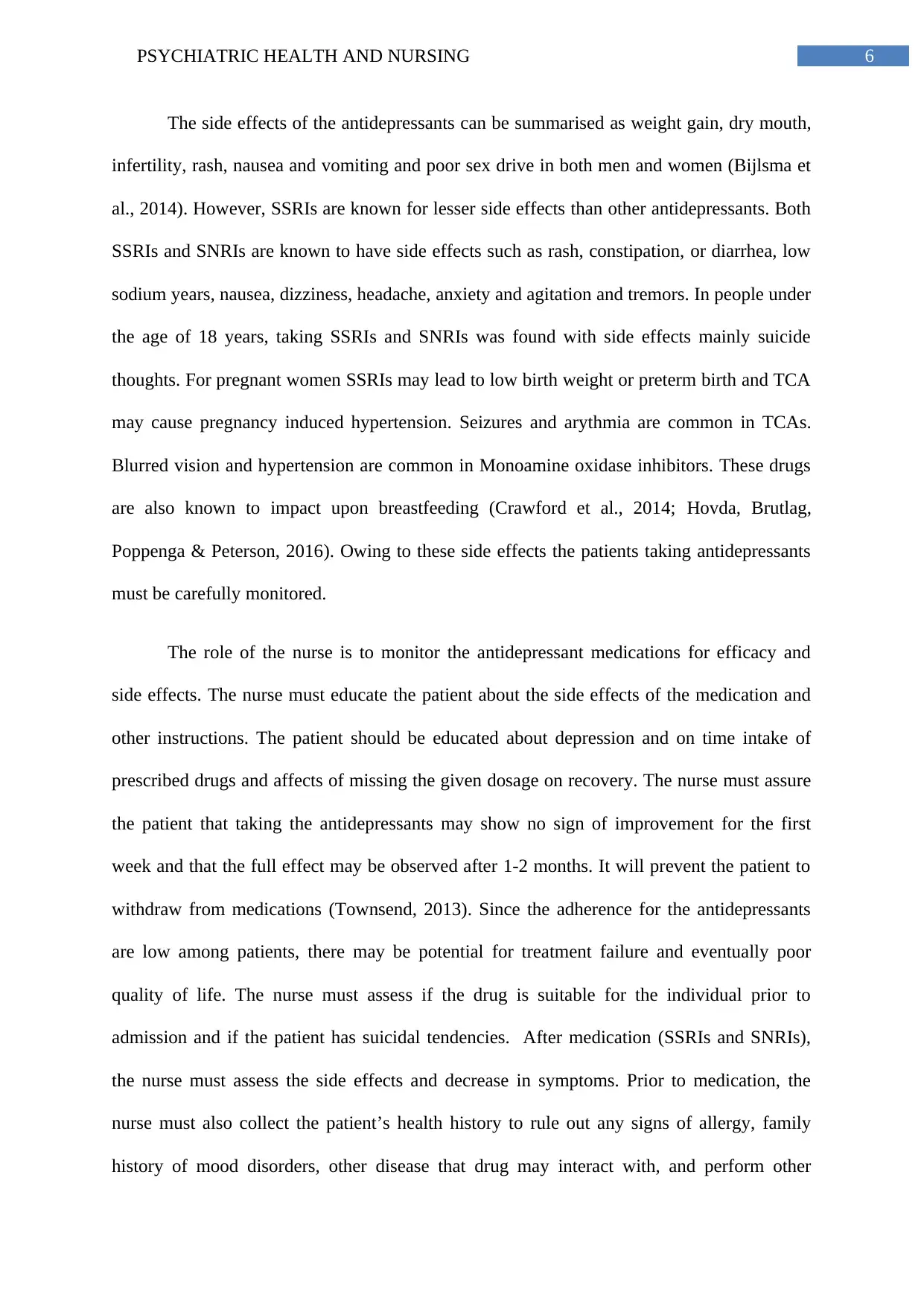
6PSYCHIATRIC HEALTH AND NURSING
The side effects of the antidepressants can be summarised as weight gain, dry mouth,
infertility, rash, nausea and vomiting and poor sex drive in both men and women (Bijlsma et
al., 2014). However, SSRIs are known for lesser side effects than other antidepressants. Both
SSRIs and SNRIs are known to have side effects such as rash, constipation, or diarrhea, low
sodium years, nausea, dizziness, headache, anxiety and agitation and tremors. In people under
the age of 18 years, taking SSRIs and SNRIs was found with side effects mainly suicide
thoughts. For pregnant women SSRIs may lead to low birth weight or preterm birth and TCA
may cause pregnancy induced hypertension. Seizures and arythmia are common in TCAs.
Blurred vision and hypertension are common in Monoamine oxidase inhibitors. These drugs
are also known to impact upon breastfeeding (Crawford et al., 2014; Hovda, Brutlag,
Poppenga & Peterson, 2016). Owing to these side effects the patients taking antidepressants
must be carefully monitored.
The role of the nurse is to monitor the antidepressant medications for efficacy and
side effects. The nurse must educate the patient about the side effects of the medication and
other instructions. The patient should be educated about depression and on time intake of
prescribed drugs and affects of missing the given dosage on recovery. The nurse must assure
the patient that taking the antidepressants may show no sign of improvement for the first
week and that the full effect may be observed after 1-2 months. It will prevent the patient to
withdraw from medications (Townsend, 2013). Since the adherence for the antidepressants
are low among patients, there may be potential for treatment failure and eventually poor
quality of life. The nurse must assess if the drug is suitable for the individual prior to
admission and if the patient has suicidal tendencies. After medication (SSRIs and SNRIs),
the nurse must assess the side effects and decrease in symptoms. Prior to medication, the
nurse must also collect the patient’s health history to rule out any signs of allergy, family
history of mood disorders, other disease that drug may interact with, and perform other
The side effects of the antidepressants can be summarised as weight gain, dry mouth,
infertility, rash, nausea and vomiting and poor sex drive in both men and women (Bijlsma et
al., 2014). However, SSRIs are known for lesser side effects than other antidepressants. Both
SSRIs and SNRIs are known to have side effects such as rash, constipation, or diarrhea, low
sodium years, nausea, dizziness, headache, anxiety and agitation and tremors. In people under
the age of 18 years, taking SSRIs and SNRIs was found with side effects mainly suicide
thoughts. For pregnant women SSRIs may lead to low birth weight or preterm birth and TCA
may cause pregnancy induced hypertension. Seizures and arythmia are common in TCAs.
Blurred vision and hypertension are common in Monoamine oxidase inhibitors. These drugs
are also known to impact upon breastfeeding (Crawford et al., 2014; Hovda, Brutlag,
Poppenga & Peterson, 2016). Owing to these side effects the patients taking antidepressants
must be carefully monitored.
The role of the nurse is to monitor the antidepressant medications for efficacy and
side effects. The nurse must educate the patient about the side effects of the medication and
other instructions. The patient should be educated about depression and on time intake of
prescribed drugs and affects of missing the given dosage on recovery. The nurse must assure
the patient that taking the antidepressants may show no sign of improvement for the first
week and that the full effect may be observed after 1-2 months. It will prevent the patient to
withdraw from medications (Townsend, 2013). Since the adherence for the antidepressants
are low among patients, there may be potential for treatment failure and eventually poor
quality of life. The nurse must assess if the drug is suitable for the individual prior to
admission and if the patient has suicidal tendencies. After medication (SSRIs and SNRIs),
the nurse must assess the side effects and decrease in symptoms. Prior to medication, the
nurse must also collect the patient’s health history to rule out any signs of allergy, family
history of mood disorders, other disease that drug may interact with, and perform other
Paraphrase This Document
Need a fresh take? Get an instant paraphrase of this document with our AI Paraphraser
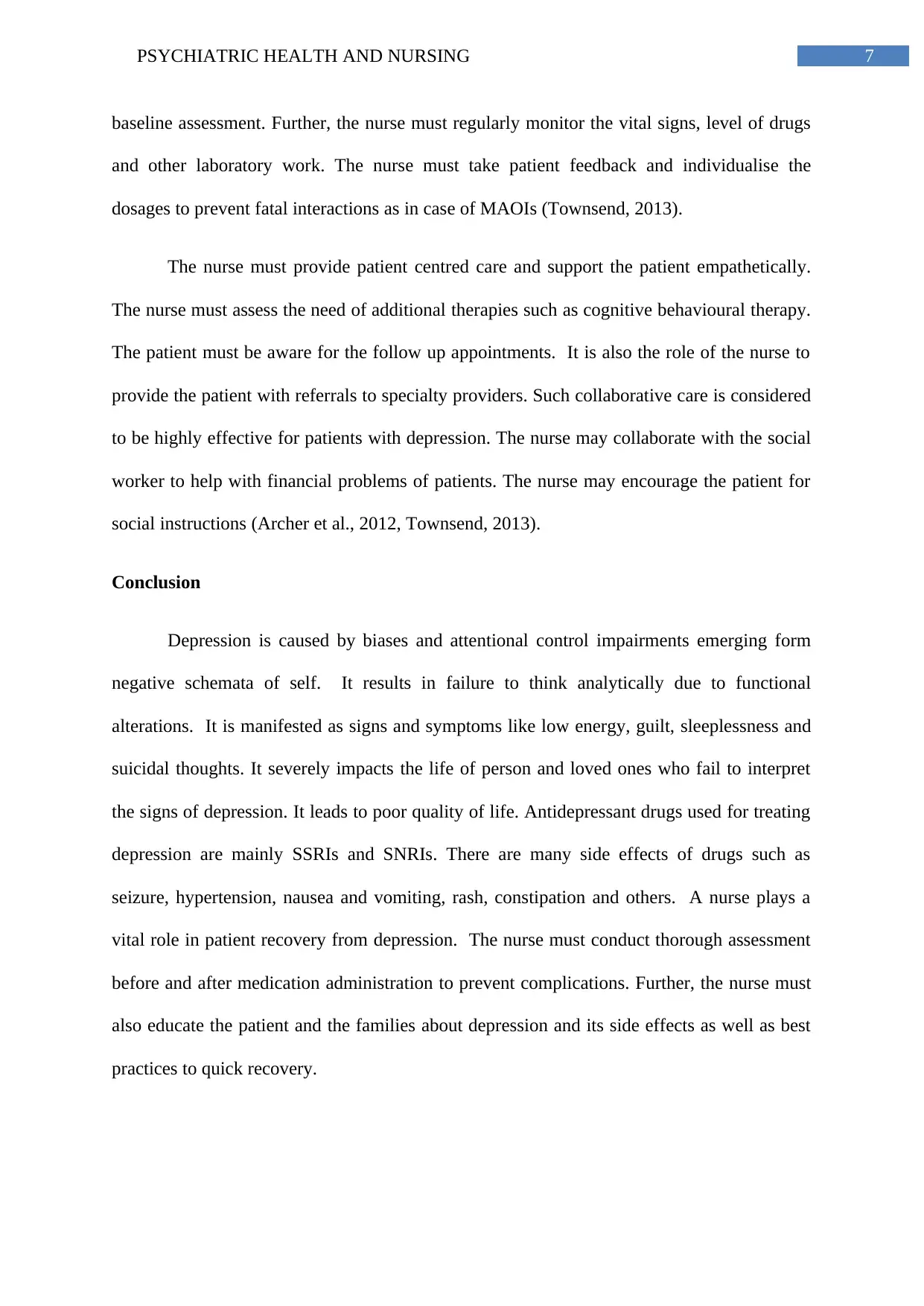
7PSYCHIATRIC HEALTH AND NURSING
baseline assessment. Further, the nurse must regularly monitor the vital signs, level of drugs
and other laboratory work. The nurse must take patient feedback and individualise the
dosages to prevent fatal interactions as in case of MAOIs (Townsend, 2013).
The nurse must provide patient centred care and support the patient empathetically.
The nurse must assess the need of additional therapies such as cognitive behavioural therapy.
The patient must be aware for the follow up appointments. It is also the role of the nurse to
provide the patient with referrals to specialty providers. Such collaborative care is considered
to be highly effective for patients with depression. The nurse may collaborate with the social
worker to help with financial problems of patients. The nurse may encourage the patient for
social instructions (Archer et al., 2012, Townsend, 2013).
Conclusion
Depression is caused by biases and attentional control impairments emerging form
negative schemata of self. It results in failure to think analytically due to functional
alterations. It is manifested as signs and symptoms like low energy, guilt, sleeplessness and
suicidal thoughts. It severely impacts the life of person and loved ones who fail to interpret
the signs of depression. It leads to poor quality of life. Antidepressant drugs used for treating
depression are mainly SSRIs and SNRIs. There are many side effects of drugs such as
seizure, hypertension, nausea and vomiting, rash, constipation and others. A nurse plays a
vital role in patient recovery from depression. The nurse must conduct thorough assessment
before and after medication administration to prevent complications. Further, the nurse must
also educate the patient and the families about depression and its side effects as well as best
practices to quick recovery.
baseline assessment. Further, the nurse must regularly monitor the vital signs, level of drugs
and other laboratory work. The nurse must take patient feedback and individualise the
dosages to prevent fatal interactions as in case of MAOIs (Townsend, 2013).
The nurse must provide patient centred care and support the patient empathetically.
The nurse must assess the need of additional therapies such as cognitive behavioural therapy.
The patient must be aware for the follow up appointments. It is also the role of the nurse to
provide the patient with referrals to specialty providers. Such collaborative care is considered
to be highly effective for patients with depression. The nurse may collaborate with the social
worker to help with financial problems of patients. The nurse may encourage the patient for
social instructions (Archer et al., 2012, Townsend, 2013).
Conclusion
Depression is caused by biases and attentional control impairments emerging form
negative schemata of self. It results in failure to think analytically due to functional
alterations. It is manifested as signs and symptoms like low energy, guilt, sleeplessness and
suicidal thoughts. It severely impacts the life of person and loved ones who fail to interpret
the signs of depression. It leads to poor quality of life. Antidepressant drugs used for treating
depression are mainly SSRIs and SNRIs. There are many side effects of drugs such as
seizure, hypertension, nausea and vomiting, rash, constipation and others. A nurse plays a
vital role in patient recovery from depression. The nurse must conduct thorough assessment
before and after medication administration to prevent complications. Further, the nurse must
also educate the patient and the families about depression and its side effects as well as best
practices to quick recovery.
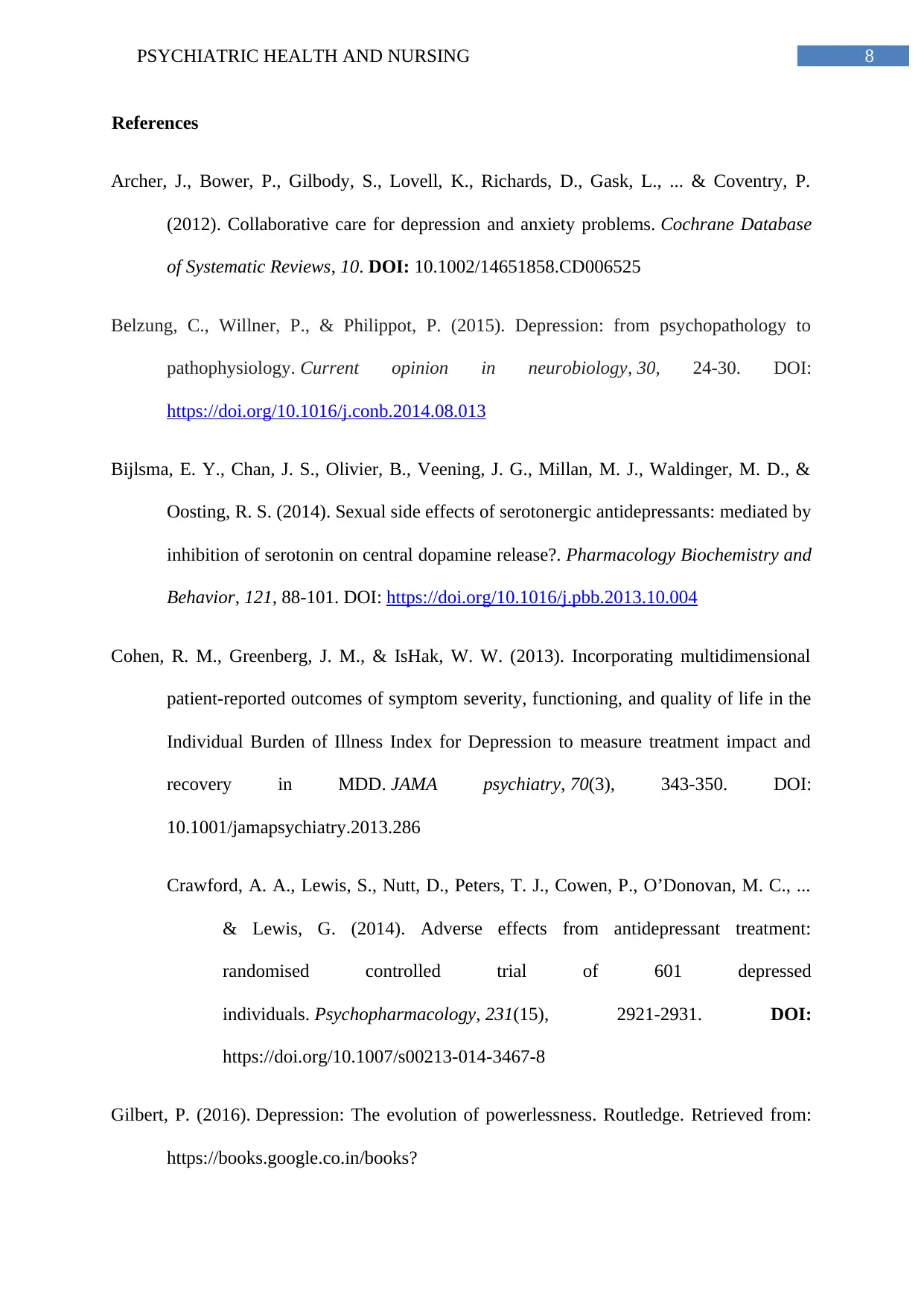
8PSYCHIATRIC HEALTH AND NURSING
References
Archer, J., Bower, P., Gilbody, S., Lovell, K., Richards, D., Gask, L., ... & Coventry, P.
(2012). Collaborative care for depression and anxiety problems. Cochrane Database
of Systematic Reviews, 10. DOI: 10.1002/14651858.CD006525
Belzung, C., Willner, P., & Philippot, P. (2015). Depression: from psychopathology to
pathophysiology. Current opinion in neurobiology, 30, 24-30. DOI:
https://doi.org/10.1016/j.conb.2014.08.013
Bijlsma, E. Y., Chan, J. S., Olivier, B., Veening, J. G., Millan, M. J., Waldinger, M. D., &
Oosting, R. S. (2014). Sexual side effects of serotonergic antidepressants: mediated by
inhibition of serotonin on central dopamine release?. Pharmacology Biochemistry and
Behavior, 121, 88-101. DOI: https://doi.org/10.1016/j.pbb.2013.10.004
Cohen, R. M., Greenberg, J. M., & IsHak, W. W. (2013). Incorporating multidimensional
patient-reported outcomes of symptom severity, functioning, and quality of life in the
Individual Burden of Illness Index for Depression to measure treatment impact and
recovery in MDD. JAMA psychiatry, 70(3), 343-350. DOI:
10.1001/jamapsychiatry.2013.286
Crawford, A. A., Lewis, S., Nutt, D., Peters, T. J., Cowen, P., O’Donovan, M. C., ...
& Lewis, G. (2014). Adverse effects from antidepressant treatment:
randomised controlled trial of 601 depressed
individuals. Psychopharmacology, 231(15), 2921-2931. DOI:
https://doi.org/10.1007/s00213-014-3467-8
Gilbert, P. (2016). Depression: The evolution of powerlessness. Routledge. Retrieved from:
https://books.google.co.in/books?
References
Archer, J., Bower, P., Gilbody, S., Lovell, K., Richards, D., Gask, L., ... & Coventry, P.
(2012). Collaborative care for depression and anxiety problems. Cochrane Database
of Systematic Reviews, 10. DOI: 10.1002/14651858.CD006525
Belzung, C., Willner, P., & Philippot, P. (2015). Depression: from psychopathology to
pathophysiology. Current opinion in neurobiology, 30, 24-30. DOI:
https://doi.org/10.1016/j.conb.2014.08.013
Bijlsma, E. Y., Chan, J. S., Olivier, B., Veening, J. G., Millan, M. J., Waldinger, M. D., &
Oosting, R. S. (2014). Sexual side effects of serotonergic antidepressants: mediated by
inhibition of serotonin on central dopamine release?. Pharmacology Biochemistry and
Behavior, 121, 88-101. DOI: https://doi.org/10.1016/j.pbb.2013.10.004
Cohen, R. M., Greenberg, J. M., & IsHak, W. W. (2013). Incorporating multidimensional
patient-reported outcomes of symptom severity, functioning, and quality of life in the
Individual Burden of Illness Index for Depression to measure treatment impact and
recovery in MDD. JAMA psychiatry, 70(3), 343-350. DOI:
10.1001/jamapsychiatry.2013.286
Crawford, A. A., Lewis, S., Nutt, D., Peters, T. J., Cowen, P., O’Donovan, M. C., ...
& Lewis, G. (2014). Adverse effects from antidepressant treatment:
randomised controlled trial of 601 depressed
individuals. Psychopharmacology, 231(15), 2921-2931. DOI:
https://doi.org/10.1007/s00213-014-3467-8
Gilbert, P. (2016). Depression: The evolution of powerlessness. Routledge. Retrieved from:
https://books.google.co.in/books?

9PSYCHIATRIC HEALTH AND NURSING
hl=en&lr=&id=WNHLDAAAQBAJ&oi=fnd&pg=PP1&dq=depression+&ots=ZAuC
NWS0-
H&sig=ZPPpz5iG47hzDdRg9DQYKxe3YkM#v=onepage&q=depression&f=false
Hovda, L. R., Brutlag, A. G., Poppenga, R. H., & Peterson, K. L. (2016). ssRI and sNRI
antidepressants. Blackwell's Five-Minute Veterinary Consult Clinical Companion:
Small Animal Toxicology, 227. Retrieved from: https://books.google.co.in/books?
hl=en&lr=&id=hxKACgAAQBAJ&oi=fnd&pg=PA227&dq=SSRI+AND+SNRI+anti
depressants+&ots=iRA-Gds0A8&sig=Ou2nK3-
NH8p_5JfGbwRTL9yNvjw#v=onepage&q=SSRI%20AND%20SNRI
%20antidepressants&f=false
Joormann, J., & Vanderlind, W. M. (2014). Emotion regulation in depression: The role of
biased cognition and reduced cognitive control. Clinical Psychological Science, 2(4),
402-421. DOI: https://doi.org/10.1177/2167702614536163
Karp, D. A. (2016). Speaking of sadness: Depression, disconnection, and the meanings of
illness. Oxford University Press. Retrieved from: https://books.google.co.in/books?
hl=en&lr=&id=YwUBDQAAQBAJ&oi=fnd&pg=PP1&dq=depression+&ots=sKBd
QPTuA3&sig=p_mvmCI3ph5xmqO7ITbVbNoVHQ0#v=onepage&q=depression&f=
false
Kishi, T., & Iwata, N. (2014). Meta-analysis of noradrenergic and specific serotonergic
antidepressant use in schizophrenia. International Journal of
Neuropsychopharmacology, 17(2), 343-354. DOI:
https://doi.org/10.1017/S1461145713000667
hl=en&lr=&id=WNHLDAAAQBAJ&oi=fnd&pg=PP1&dq=depression+&ots=ZAuC
NWS0-
H&sig=ZPPpz5iG47hzDdRg9DQYKxe3YkM#v=onepage&q=depression&f=false
Hovda, L. R., Brutlag, A. G., Poppenga, R. H., & Peterson, K. L. (2016). ssRI and sNRI
antidepressants. Blackwell's Five-Minute Veterinary Consult Clinical Companion:
Small Animal Toxicology, 227. Retrieved from: https://books.google.co.in/books?
hl=en&lr=&id=hxKACgAAQBAJ&oi=fnd&pg=PA227&dq=SSRI+AND+SNRI+anti
depressants+&ots=iRA-Gds0A8&sig=Ou2nK3-
NH8p_5JfGbwRTL9yNvjw#v=onepage&q=SSRI%20AND%20SNRI
%20antidepressants&f=false
Joormann, J., & Vanderlind, W. M. (2014). Emotion regulation in depression: The role of
biased cognition and reduced cognitive control. Clinical Psychological Science, 2(4),
402-421. DOI: https://doi.org/10.1177/2167702614536163
Karp, D. A. (2016). Speaking of sadness: Depression, disconnection, and the meanings of
illness. Oxford University Press. Retrieved from: https://books.google.co.in/books?
hl=en&lr=&id=YwUBDQAAQBAJ&oi=fnd&pg=PP1&dq=depression+&ots=sKBd
QPTuA3&sig=p_mvmCI3ph5xmqO7ITbVbNoVHQ0#v=onepage&q=depression&f=
false
Kishi, T., & Iwata, N. (2014). Meta-analysis of noradrenergic and specific serotonergic
antidepressant use in schizophrenia. International Journal of
Neuropsychopharmacology, 17(2), 343-354. DOI:
https://doi.org/10.1017/S1461145713000667
Secure Best Marks with AI Grader
Need help grading? Try our AI Grader for instant feedback on your assignments.
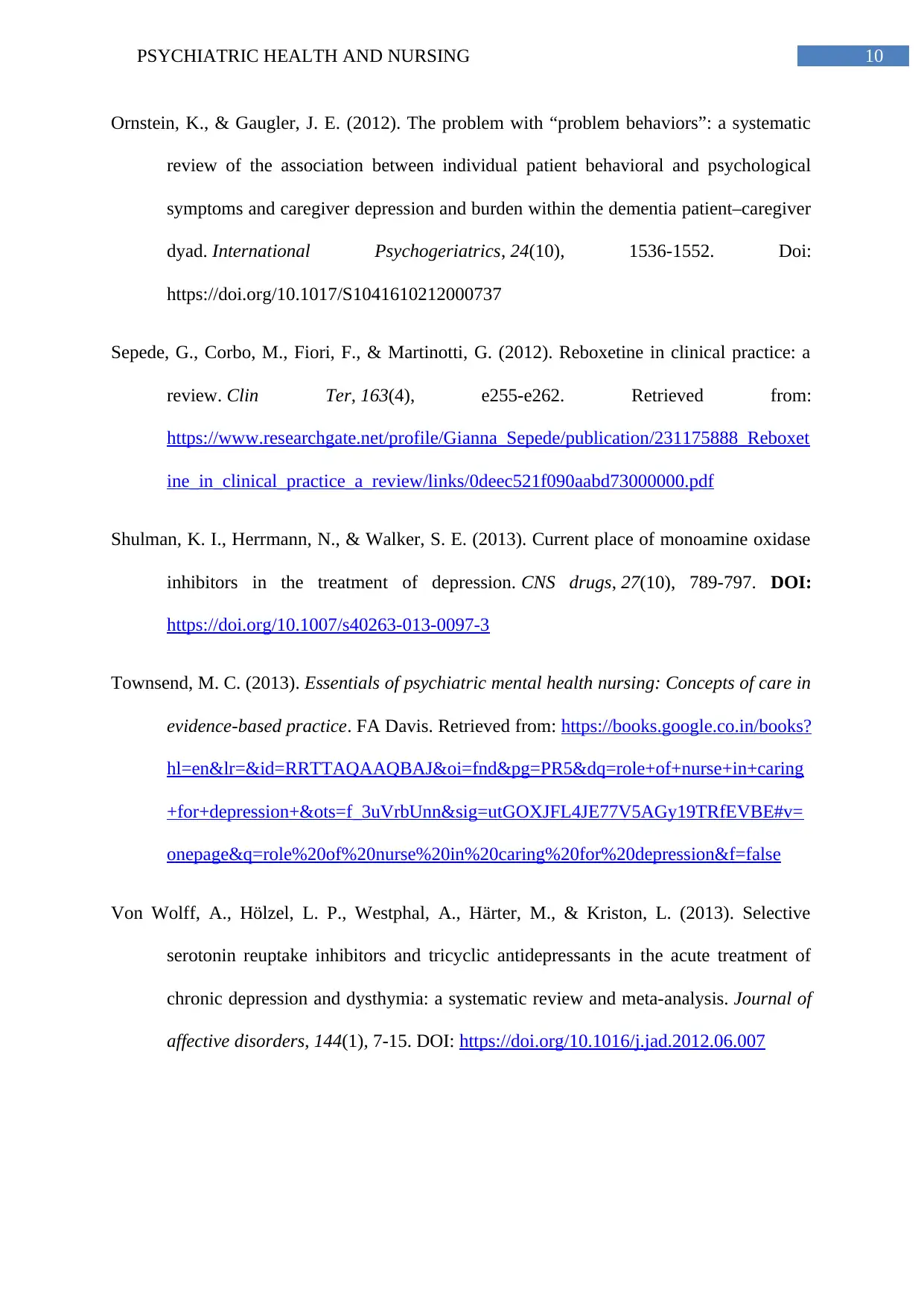
10PSYCHIATRIC HEALTH AND NURSING
Ornstein, K., & Gaugler, J. E. (2012). The problem with “problem behaviors”: a systematic
review of the association between individual patient behavioral and psychological
symptoms and caregiver depression and burden within the dementia patient–caregiver
dyad. International Psychogeriatrics, 24(10), 1536-1552. Doi:
https://doi.org/10.1017/S1041610212000737
Sepede, G., Corbo, M., Fiori, F., & Martinotti, G. (2012). Reboxetine in clinical practice: a
review. Clin Ter, 163(4), e255-e262. Retrieved from:
https://www.researchgate.net/profile/Gianna_Sepede/publication/231175888_Reboxet
ine_in_clinical_practice_a_review/links/0deec521f090aabd73000000.pdf
Shulman, K. I., Herrmann, N., & Walker, S. E. (2013). Current place of monoamine oxidase
inhibitors in the treatment of depression. CNS drugs, 27(10), 789-797. DOI:
https://doi.org/10.1007/s40263-013-0097-3
Townsend, M. C. (2013). Essentials of psychiatric mental health nursing: Concepts of care in
evidence-based practice. FA Davis. Retrieved from: https://books.google.co.in/books?
hl=en&lr=&id=RRTTAQAAQBAJ&oi=fnd&pg=PR5&dq=role+of+nurse+in+caring
+for+depression+&ots=f_3uVrbUnn&sig=utGOXJFL4JE77V5AGy19TRfEVBE#v=
onepage&q=role%20of%20nurse%20in%20caring%20for%20depression&f=false
Von Wolff, A., Hölzel, L. P., Westphal, A., Härter, M., & Kriston, L. (2013). Selective
serotonin reuptake inhibitors and tricyclic antidepressants in the acute treatment of
chronic depression and dysthymia: a systematic review and meta-analysis. Journal of
affective disorders, 144(1), 7-15. DOI: https://doi.org/10.1016/j.jad.2012.06.007
Ornstein, K., & Gaugler, J. E. (2012). The problem with “problem behaviors”: a systematic
review of the association between individual patient behavioral and psychological
symptoms and caregiver depression and burden within the dementia patient–caregiver
dyad. International Psychogeriatrics, 24(10), 1536-1552. Doi:
https://doi.org/10.1017/S1041610212000737
Sepede, G., Corbo, M., Fiori, F., & Martinotti, G. (2012). Reboxetine in clinical practice: a
review. Clin Ter, 163(4), e255-e262. Retrieved from:
https://www.researchgate.net/profile/Gianna_Sepede/publication/231175888_Reboxet
ine_in_clinical_practice_a_review/links/0deec521f090aabd73000000.pdf
Shulman, K. I., Herrmann, N., & Walker, S. E. (2013). Current place of monoamine oxidase
inhibitors in the treatment of depression. CNS drugs, 27(10), 789-797. DOI:
https://doi.org/10.1007/s40263-013-0097-3
Townsend, M. C. (2013). Essentials of psychiatric mental health nursing: Concepts of care in
evidence-based practice. FA Davis. Retrieved from: https://books.google.co.in/books?
hl=en&lr=&id=RRTTAQAAQBAJ&oi=fnd&pg=PR5&dq=role+of+nurse+in+caring
+for+depression+&ots=f_3uVrbUnn&sig=utGOXJFL4JE77V5AGy19TRfEVBE#v=
onepage&q=role%20of%20nurse%20in%20caring%20for%20depression&f=false
Von Wolff, A., Hölzel, L. P., Westphal, A., Härter, M., & Kriston, L. (2013). Selective
serotonin reuptake inhibitors and tricyclic antidepressants in the acute treatment of
chronic depression and dysthymia: a systematic review and meta-analysis. Journal of
affective disorders, 144(1), 7-15. DOI: https://doi.org/10.1016/j.jad.2012.06.007
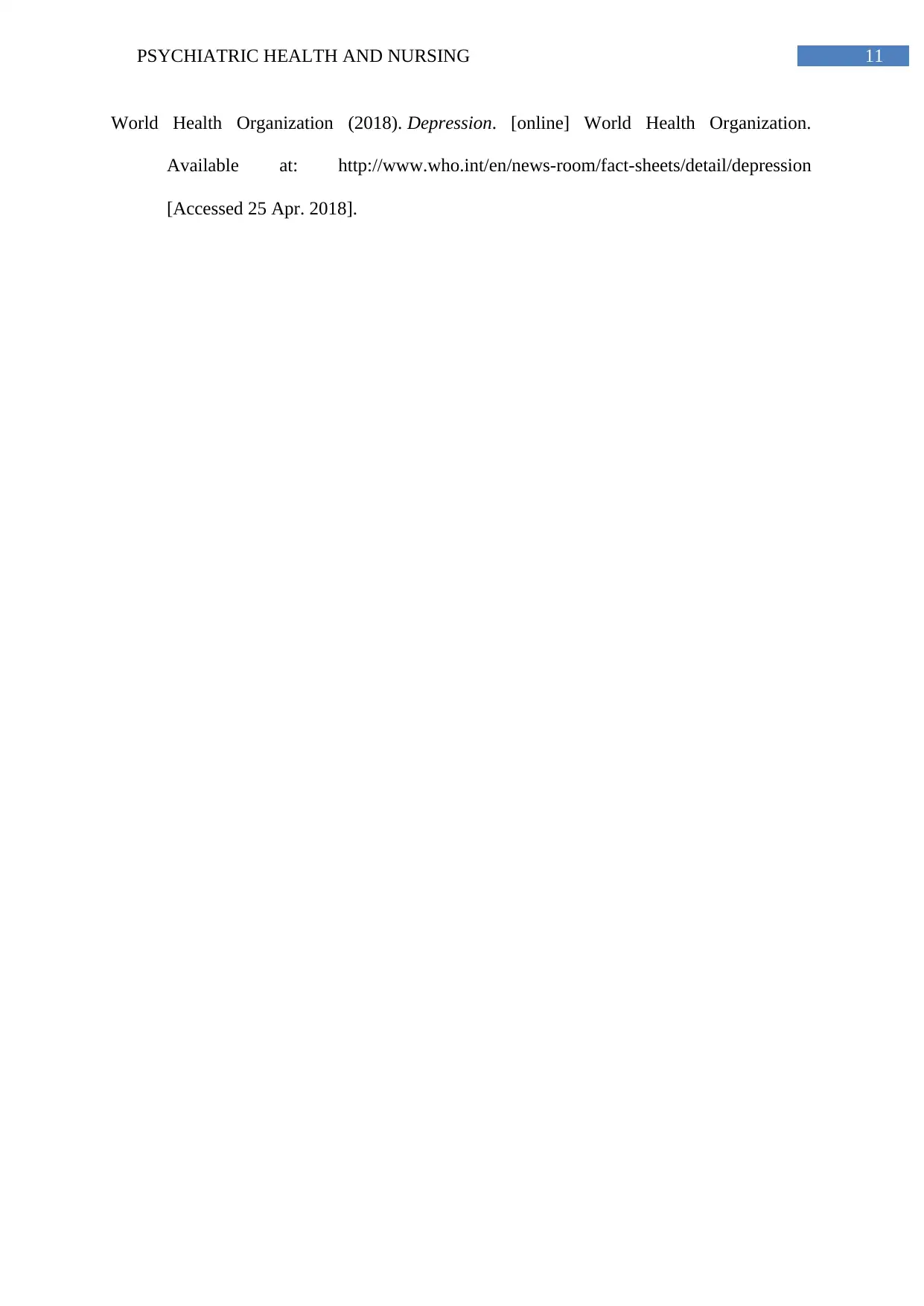
11PSYCHIATRIC HEALTH AND NURSING
World Health Organization (2018). Depression. [online] World Health Organization.
Available at: http://www.who.int/en/news-room/fact-sheets/detail/depression
[Accessed 25 Apr. 2018].
World Health Organization (2018). Depression. [online] World Health Organization.
Available at: http://www.who.int/en/news-room/fact-sheets/detail/depression
[Accessed 25 Apr. 2018].
1 out of 12
Related Documents
Your All-in-One AI-Powered Toolkit for Academic Success.
+13062052269
info@desklib.com
Available 24*7 on WhatsApp / Email
![[object Object]](/_next/static/media/star-bottom.7253800d.svg)
Unlock your academic potential
© 2024 | Zucol Services PVT LTD | All rights reserved.





